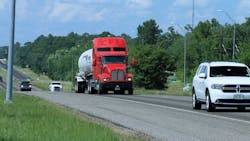TANK truck fleets seem to have fared reasonably well under the Phase 2 greenhouse gas emission proposed regulations announced by the Environmental Protection Agency (EPA) and the National Highway Traffic Safety Administration (NHTSA). The compliance burden will fall heaviest on general freight haulers.
Announced August 16, the Phase 2 final rules for commercial trucks and trailers are intended to promote a new generation of cleaner, more fuel efficient trucks by encouraging wider application of currently available technologies and the development of new and advanced cost-effective technologies through model year 2027, according to federal environmental and transportation officials. The stated goal of the EPA and NHTSA is to lower CO2 emissions by approximately 1.1 billion metric tonnes, save vehicle owners fuel costs of roughly $170 billion, and reduce oil consumption by up to two billion barrels over the lifetime of the vehicles sold under the program.
For the first time, a set of CO2 emission and fuel consumption standards for manufacturers of new trailers will take effect over a period of nine years, according to a pre-publication version of the final rules. The joint rulemaking has been signed by Secretary of Transportation Anthony Foxx and the Environmental Protection Agency Administrator Gina McCarthy. The rules will become law 60 days after publication in the Federal Register. The rationale for applying the rules to trailers is that regulators consider trailers to be an integral part of the tractor-trailer vehicle.
“Tank trailer buyers make out very well with the final rule,” says John Freiler, Truck Trailer Manufacturers Association engineering manager. “Tank trailers built under the new rule will just need tire inflation management or monitoring systems and low-rolling-resistance tires.
“What tank trailer buyers need to understand is that those components now become EPA emission control devices, and fines can be levied for equipment that is inoperable. The fines are $7,500 per non-functioning component.”
Dry bulk trailers are a big question mark in the final rule as it currently stands, because those trailers are not defined as tank trailers. “We don’t think this will be left as is,” Freiler says. “We think we will see plenty of letters of interpretation to resolve various problem areas in the GHG Phase 2 rule.”
Freiler added that he expects some level of tank trailer pre-buy before 2018. More rebuilding also is likely for older tank trailers. “We may see tank trailer glider kits, because many of these trailers can be rebuilt indefinitely,” he says.
Cost effective
Federal officials stressed that they believe the final rules are cost effective for consumers and businesses, delivering favorable payback periods for truck owners. The buyer of a new longhaul truck in 2027 should recoup the investment in fuel-efficient technology in less than two years through fuel savings. The GHG-related trailer technologies also should have a payback of less than two years.
Here are some of the key provisions of the final rule, which will consume 1,690 pages in the Federal Register:
• Phase 2 will affect companies that manufacture, sell, or import into the United States medium- and heavy-duty vehicles, including trucks, trailers, buses, and work trucks. The final standards will phase in gradually, beginning in the 2018 model year. New regulated trailers built on or after January 1, 2018 need to be certified to the new CO2 emissions standards. NHTSA fuel consumption standards are voluntary until model year 2021.
• Trailer manufacturers disagreed on the wisdom of implementing a “corporate average fuel economy” (CAFE) system on trailers. The final rule reflects that disagreement.
“In order to balance the advantage of an averaging program in allowing for introduction of the most reasonably stringent standards for trailers with the concerns articulated by manufacturers, the final program accordingly limits the option for trailer manufacturers to apply averaging exclusively to MYs 2027 and later for full-aero box vans only,” the final rule states. “We believe this delay provides box van manufacturers sufficient time to develop, evaluate and market new technologies and to become familiar with the compliance process and possible benefits of averaging. This will also allow customers to become more familiar with the technologies and to recognize their benefits.”
• At varying levels of stringency, the standard will apply to two types of vans—those that can be fully equipped with aerodynamic devices and those with work-producing equipment such as liftgates that restrict the full use of aerodynamic devices. It also will apply to “non-box van” trailers, including tanks, platforms, and container chassis. These will be required to use low rolling resistance tires, along with tire inflation systems, but will not be required to have aerodynamic devices.
Excluded trailers include:
• All trailers with four or more axles.
• Trailers less than 35 feet long with three axles.
• Trailers with an axle spread of at least 120 inches between adjacent axle centerlines. The axle spread exclusion does not apply to trailers with adjustable axles that have the ability to be spaced less than 120 inches apart.
• Miscellaneous trailers such as mobile homes and trailers intended for temporary or permanent residence, office space, or other work space, and carnival trailers. ♦
About the Author
Charles Wilson
Charles E. Wilson spent 31 years covering the tank truck, tank container, and storage terminal industries throughout North, South, and Central America as the editor of Bulk Transporter. Prior to 1989, Wilson was managing editor of Bulk Transporter and Refrigerated Transporter and associate editor of Trailer/Body Builders. Before joining the three publications in Houston TX, he wrote for various food industry trade publications in other parts of the country. Wilson has a bachelor's degree in journalism from the University of Kansas and served three years in the U.S. Army.
